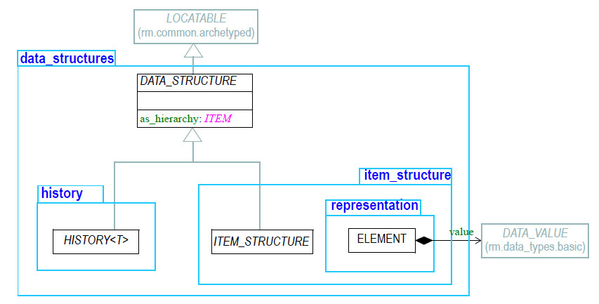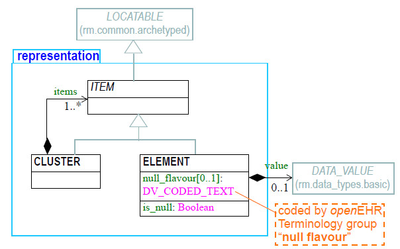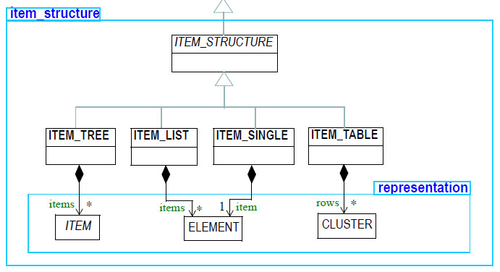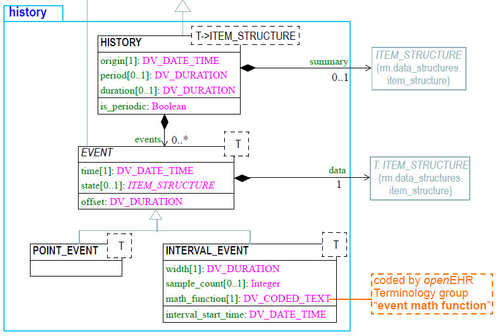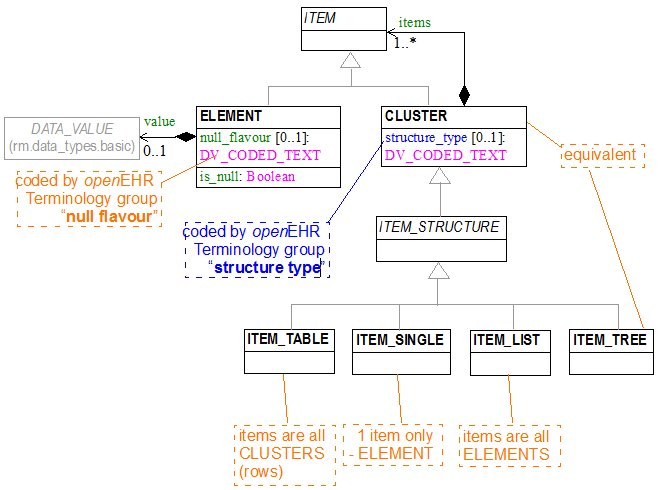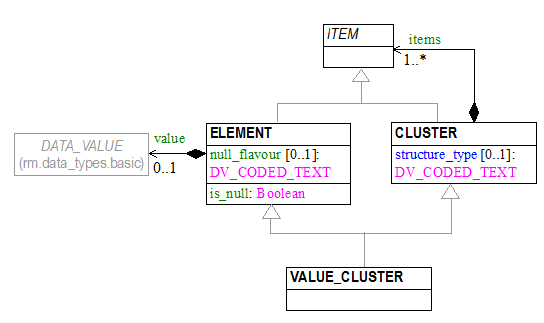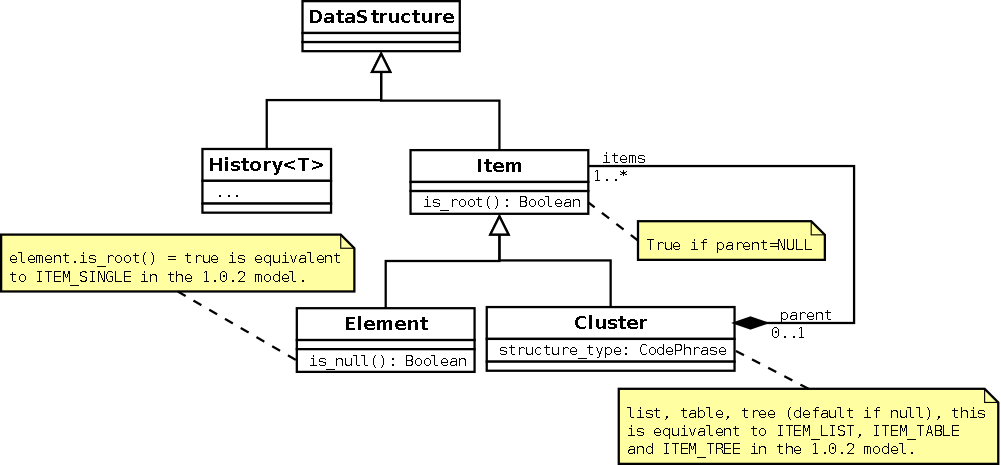Introduction
This page is describes changes proposed to the openEHR release 1.0.2 Reference Model (RM) in response to the many lessons learned over the years since its publication. The issues driving the changes are recorded on the Jira SPECPR issue tracker .
DATA_STRUCTURE classes
Needs
- solve the pizza problem - multi-value items
- ITEM_SINGLE, ITEM_LIST etc are not used much in archetyping, and are also not flexible enough because they cannot occur anywhere in a CLUSTER structure
- add a type that is a mixture of CLUSTER and ELEMENT, i.e. has a value and also children, to allow for the fractal nature of data, with a 'summary' value, plus underlying detail
The current data structure models are shown below.
|
|
|
|
Problems
Problems / irritations with the above models appear to include the following:
- few archetypes use anything but ITEM_TREE because it appears that one 'can never know' if some more detail will be needed later
- TB: but what about things like Apgar, Barthel etc - surely they are linear lists?
- also, it appears that some form of 'table' structure is still needed
- ITEM_TREE, ITEM_LIST etc cannot be nested inside each other arbitrarily.
- the structures complicate the software unnecessarily, without adding much value (this would clearly be true if no/limited use is being made of ITEM_LIST, ITEM_SINGLE) - [question: by "use is being made", do you mean use of the class methods in software or use of the structuring possibilities? The structuring possibilities will remain if a structure_type variable is used.]
- Depending on how you write and divide/distribute software functionality, having ITEM_STRUCTURE subclasses may just complicate class structure and not add any value at all in server/backend/query code and storage. Storing the same structure/presentation info in a structure_type variable will still give GUI code what it needs for validation and presentation but a handful of classes less to implement and maintain e.g. on the server side. Some implementations (or parts of implementations) handle openEHR structures mainly as documents, not objects, thus only stored attributes, not object methods, are used - in those cases the methods of ITEM_STRUCTURE subclasses bring absolutely no value and a structure_type variable would be easier to handle than having to store or infer object type info.
- When learning and presenting openEHR, there will be fewer classes and one level of nesting less to consider, making the design less cluttered.
- "Perfection is achieved, not when there is nothing more to add, but when there is nothing left to take away." - Antoine de Saint-Exupery
- archetype paths are made longer and more complex ... MORE INFO REQUIRED - WHAT'S THE PROBLEM?** Paths are used e.g. in AQL queries - shortening or simplification of paths make queries easier to read, write and understand.
- Having fewer nesting levels to traverse in hierarchical database backends (e.g. network-DBs and XML-DBs) or ORM mapping frameworks when fetching data from queries would likely improve performance.
- Shorter paths also means less to parse and translate for the query processing software, but without measuring the impact of this it is not possible to say if it matters very much for performance in practice.
Below, various simplified models are proposed, each with an impact analysis.
Candidate A - make ITEM_STRUCTURE inherit from CLUSTER
Proposal - Thomas Beale
Status
under construction
Design concept
- Keep ITEM_STRUCTURE and children, but just make them a variety of CLUSTER. Impact remaining model as little as possible.
Changes
- ITEM_STRUCTURE now inherits from CLUSTER.
- all static declarations in the remainder of the RM for ITEM_STRUCTURE changed to CLUSTER. In theory they should stay ITEM_STRUCTURE, but the problem is that with no static declarations anywhere for CLUSTER or ITEM, CLUSTER archetypes have no place to go, and the CLUSTER type is not detected by my current 'type closure' detecting algorithm. This should probably be changed.
- the types ITEM_TREE, ITEM_SINGLE, ITEM_TABLE, ITEM_LIST could be kept as programming types for manipulating the specific kinds of data structure.
Diagram
Impact Analysis
Component |
Impact |
|---|---|
On RM |
|
On existing archetypes |
|
On archetype tooling |
|
On existing RM-1.0.2 based software |
|
On existing RM 1.0.2 data |
|
Discussion
Candidate A.1 - Add VALUE_CLUSTER, Remove ITEM_STRUCTURE types
Proposal - Thomas Beale / Ian McNicoll
Status
Under development
Design Concept
In this model, a new class is added that combines CLUSTER and ELEMENT. This reflects the fractal nature of reality. Initially you think you have just an ELEMENT, but later on, people want to start recording more fine detail. In the other direction, information users often want a 'summary' data point for a collection of details.
This model is not intended as a 'final solution', just to show what is needed (a CLUSTER-with-value idea), and one way to model it. The technical needs we are trying to meet here are:
- retain CLUSTER and ELEMENT classes, since they remain useful, are already defined, and map cleanly to 13606-1
- support efficient, shortest possible path to a summary data item (e.g. 'smoking status' = Smoker)
- ensure that if the summary item is added runtime, e.g. by converting a CLUSTER to the new CLUSTER+value type, the paths of the underlying detailed items don't change
- ensure that if an ELEMENT is converted to a CLUSTER+value at runtime, the path of the ELEMENT.value does not change
- make it so that a specialised archetype can convert a CLUSTER or ELEMENT to a CLUSTER+value type
Changes
A new VALUE_CLUSTER, inheriting from ELEMENT and CLUSTER provides the semantics of both: a node which can itself have a value (like an ELEMENT), but may still hvae substructure. By inheriting from both CLUSTER and ELEMENT, it means that where either of these two are currently specified in the RM or archetypes, VALUE_CLUSTER could be substituted at runtime.The downside of this model is that there is no way to force a node to be just an ELEMENT or CLUSTER, since the new type is always substitutable.
Diagram
Impact Analysis
Component |
Impact |
|---|---|
On RM |
|
On existing archetypes |
|
On archetype tooling |
|
On existing RM-1.0.2 based software |
|
On existing RM 1.0.2 data |
|
Discussion
- Questions/thoughts from Erik Sundvall: The above VALUE_CLUSTER sugestion is an interesting change, and if flexibility is what is sought for, then perhaps the simplification can be taken even further...
- Now the current ITEM+ELEMENT+CLUSTER follows the composite design pattern (see c2 wiki and wikipedia http://en.wikipedia.org/wiki/Composite_pattern). But since there are not many common operations/methods shared by ELEMENTs and CLUSTERs (except the ones already in PATHABLE/LOCATABLE) then perhaps the composite design pattern is not needed/helpful in this part of the openEHR structure. (Also see discussions at CompositeConsideredHarmful and maybe this.)
- If the contents of both ELEMENT and CLUSTER are pushed up to ITEM then we get the same functionality as proposed in VALUE_CLUSTER, but with fewer classes. (ITEM_STRUCTURE will not be needed, see the "Middle and Lower IM"-suggestion further down on this page, but perhaps ITEM_STRUCTURE would be a better name than ITEM for this new super-ITEM with VALUE_CLUSTER capabilities). And one (debatable) way of looking at the ITEM/ITEM_STRUCTURE family of classes is to consider them as being just for structuring and naming nodes internally in a hierarchy and considering the the DATA_VALUE classes to be the real leafs. (Yes, debatable...)
- Perhaps what is mentioned as a "downside" above (not being able to force ELEMENT or CLUSTER) is achievable (if wanted) by archetyping a new super-ITEM to have 0 items (forcing ELEMENT-functionallity) or 1..* items (forcing CLUSTER-functionality)? Also, perhaps "value" can be archetyped as disallowed if you rally want to force value-less CLUSTER behaviour.
Candidate B - Remove ITEM_STRUCTURE
Proposal - Pablo Pazos
Status
under construction
Design concept
- Remove ITEM_STRUCTURE and use ITEM for structures without losing meaning/semantics/modeling capabilities.
Changes
- Removed ITEM_STRUCTURE and children.
- Added attribute structure_type:CODE_PRHASE to CLUSTER (as in 13606 model)
- Added method is_root() to ITEM
- ITEM inherits from DATA_STRUCTURE
- Added backguards relationship "parent" from ITEM to CLUSTER
Diagram
I have the source of this diagram if anyone wants it, it's a .dia file (http://live.gnome.org/Dia)
Impact Analysis
Component |
Impact |
|---|---|
On RM |
RM change |
On existing archetypes |
RM change |
On archetype tooling |
RM change |
On existing RM-1.0.2 based software |
RM change |
On existing RM 1.0.2 data |
transformation needed |
Candidate C - class renaming for easier explanation
Proposal - Erik Sundvall
Status
under construction
Design Concept
Below is an initial suggestion based on some previous mail threads
(TODO: find links to more threads in mail-archive)
Changes
Diagram
'UML' image above produced by pasting the "diagram sourcecode" below to http://yuml.me/diagram/scruffy/class/draw2 (initially by Erik Sundvall)
The yellow stuff is what I guess could be in a 13606-1(a?) "healthcare a-specific" update and the rest in a new 13606-6 or 13606-1b healthcare-specific part.
I have likely missed some details (and did not have time to add datatypes to all attributes, but they are in the openEHR specs).
Update: The attribute "structure" in the class "CLUSTER" could of course be named "structure_type" instead as in candidate A and B if that is preferred.
[note: No change suggestions in ACTION and INSTRUCTION except that ITEM_STRUCTURE type is replaced by ITEM]
[CONTENT_ITEM{bg:yellow}]]^[SECTION|0..* items: List CONTENT_ITEM{bg:yellow}]
[CONTENT_ITEM]^[ENTRY|data: ITEM{bg:yellow}]]
[CONTENT_ITEM]^[ABSTRACT_CARE_ENTRY|0..1 protocol: ITEM;0..1 guideline_id: OBJECT_REF;0..1 workflow_id: OBJECT_REF;language: CODE_PHRASE;encoding: CODE_PHRASE;subject: PARTY_PROXY;0..1 provider: PARTY_PROXY;0..1 other_participations: List PARTICIPATION; ]
[ABSTRACT_CARE_ENTRY]^[CARE_ENTRY|data: ITEM]
[CARE_ENTRY]-[note:CARE_ENTRY Replaces both ADMIN_ENTRY and EVALUATION.]
[ABSTRACT_CARE_ENTRY]^[OBSERVATION|data: EVENTS;0..1 state: EVENTS]
[ABSTRACT_CARE_ENTRY]^[INSTRUCTION]
[ABSTRACT_CARE_ENTRY]^[ACTION]
[ENTRY]-[note:ENTRY replaces GENERIC_ENTRY and is intended also for 'healthcare a-specific' stuff as indicated useful by 13606 experiences]
[EVENTS|origin;0..1 period;0..1 duration]++-events>[EVENT|time;0..1 state: ITEM; data: ITEM]]
[EVENTS]-[note: HISTORY renamed to EVENTS]
[EVENT]^[INTERVAL_EVENT|width;0..1 sample_count;math_function]
[ITEM{bg:yellow}]^[ELEMENT|0..1 null_flavor;0..1 value DATA_VALUE{bg:yellow}]
[ITEM]^[CLUSTER|1..* items: ITEM;0..1 structure: CODE_PHRASE{bg:yellow}]
[CLUSTER]-[note: 'structure' indicates if the cluster is to be validated and interpereted as e.g. a table or list - defaulting to tree if not provided]
Impact Analysis
Component |
Impact |
|---|---|
On RM |
|
On existing archetypes |
|
On archetype tooling |
|
On existing RM-1.0.2 based software |
|
On existing RM 1.0.2 data |
|
Discussion
xxx
